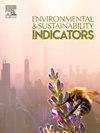Quantifying urban land expansion using remote sensing data and multi-evaluation indices in the Lower Yellow River, China
IF 5.4
Q1 ENVIRONMENTAL SCIENCES
引用次数: 0
Abstract
Monitoring and assessing the dynamic trajectory, spatial patterns, and sustainability of urban construction land expansion is crucial for achieving the Sustainable Development Goals (SDGs) and has become a key issue in current urban research. This study proposes an urban expansion assessment framework that leverages the "trend-pattern-efficiency-coordination" research path to monitor the spatiotemporal dynamics and sustainability of urban expansion in China's Lower Yellow River urban agglomeration (LYR) from 1990 to 2020 at 10-year intervals with multi-source remote sensing images and socioeconomic census data. The research findings indicated a significant acceleration in LYR's urban land growth over the past three decades, albeit with pronounced regional disparities in the magnitude and trend of urban land expansion across different prefectural cities. This study further integrated radar map and equal fan analysis to identify three dominant urban expansion patterns, explicitly showing the dominant direction and spatial shape features. Additionally, the EGRLCR and EGRPGR revealed a consistent downward trend from 1990 to 2020, with the LCRPGR ratio experiencing an initial decline followed by an increase over time. The investigation into the coupling coordination degree showed that most cities were in the high-level coupling stage accompanied by the continuously strengthening degree of coupling coordination. This paper also puts forward targeted countermeasures for cities experiencing uncoordinated urbanization to boost land use efficiency and sustainability.
基于遥感数据和综合评价指标的黄河下游城市用地扩张量化研究
监测和评估城市建设用地扩张的动态轨迹、空间格局和可持续性对实现可持续发展目标至关重要,已成为当前城市研究的关键问题。基于多源遥感影像和社会经济普查数据,提出了基于“趋势-模式-效率-协调”研究路径的城市扩张评价框架,对1990 - 2020年中国黄河下游城市群(LYR)城市扩张的时空动态和可持续性进行了10年的监测。研究结果表明,尽管不同地级市的城市土地扩张幅度和趋势存在明显的区域差异,但在过去30年里,LYR的城市土地增长速度显著加快。进一步将雷达图与等扇分析相结合,识别出三种城市扩张主导格局,明确了城市扩张的主导方向和空间形态特征。1990 ~ 2020年EGRLCR和EGRPGR呈持续下降趋势,LCRPGR先下降后上升。耦合协调度调查表明,大部分城市处于高耦合阶段,耦合协调度不断增强。针对城市化不协调的城市,提出了提高土地利用效率和可持续性的针对性对策。
本文章由计算机程序翻译,如有差异,请以英文原文为准。
求助全文
约1分钟内获得全文
求助全文
来源期刊

Environmental and Sustainability Indicators
Environmental Science-Environmental Science (miscellaneous)
CiteScore
7.80
自引率
2.30%
发文量
49
审稿时长
57 days
 求助内容:
求助内容: 应助结果提醒方式:
应助结果提醒方式:


